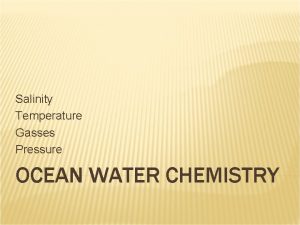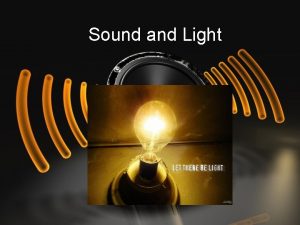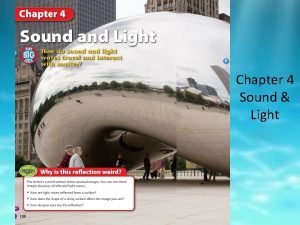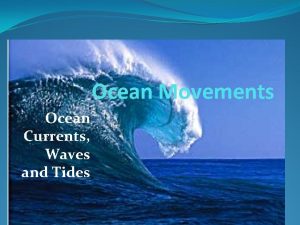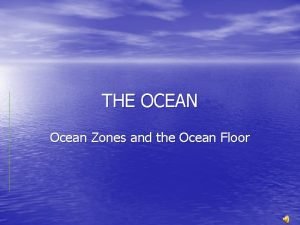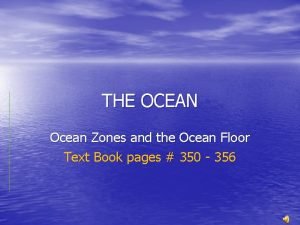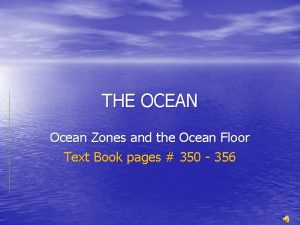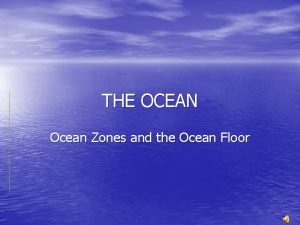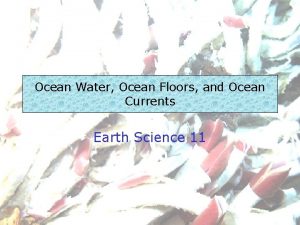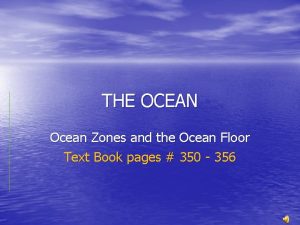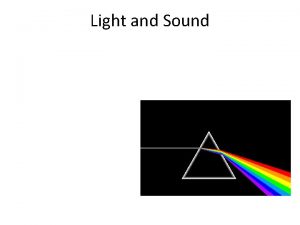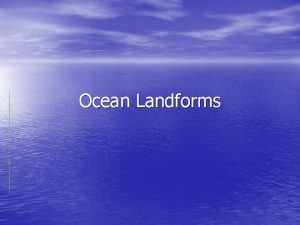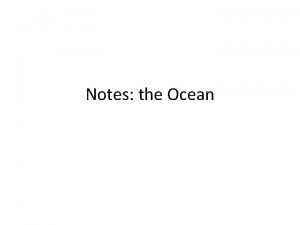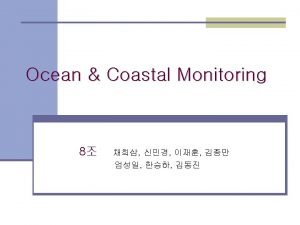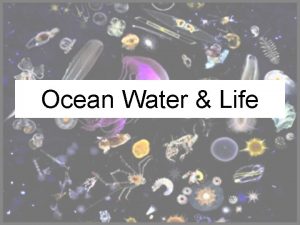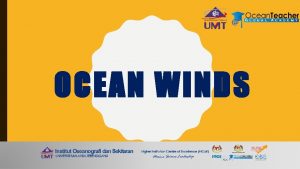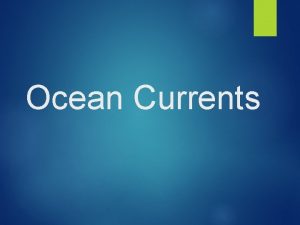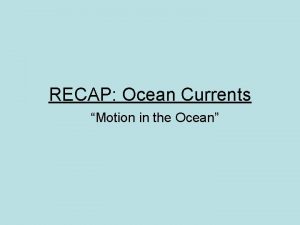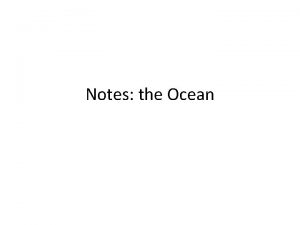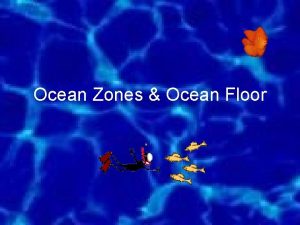Light and Sound in the Ocean Light Sound











































- Slides: 43

Light and Sound in the Ocean

Light & Sound • Both are waves

Refraction • Bending of waves • When waves leave medium of one density and enter medium of another density at an angle other than 90 o it is bent • Waves travel at different speeds in different media


Why is light important • Photosynthesis in the ocean • Phytoplankton themselves absorb light to get energy

Light • Speed of light in water is about 0. 75 times the speed of light in air so light is refracted • The degree to which light is refracted from one medium to another is the REFRACTIVE INDEX • The higher the refractive index, the greater the bending • Refractive index (or bending) increases with increasing salinity

Broken rainbow – atmospheric rainbow meets seawater

Light wavelengths • Light is electromagnetic radiation and travels as waves • Visible spectrum – the wavelengths that can be seen by the human eye • Other wavelengths include radio waves, infrared, ultraviolet and x-rays • Shorter wavelengths are blue • Longer wavelengths are red • Water rapidly absorbs nearly all electromagnetic radiation • Only blue and green wavelengths pass through water in any significant quantity or distance

ROY G BIV from long to short • We see reflected light. If color is absorbed, we don’t see it!

Light reaching the sea surface • Clouds and sea surface reflect light • Atmospheric gases and particles scatter and absorb light • Once past the sea surface, light is rapidly attenuated by scattering and absorption

Scattering & Absorption • Scattering – light is bounced between molecules, particles, or other objects – More prevalent in water than air because more particles and higher density • Absorption – governed by the structure of water molecules it strikes – Absorbed light energy is converted to heat (causes molecules to vibrate)

Light in the ocean • Why doesn’t light reach the bottom? – Even clear water is not transparent • Photic zone – depth to which light penetrates – Typically about 100 m (may be deeper in clear water) in the open ocean – Shallower (e. g. , 40 m) in coastal waters – Zone where photosynthetic organisms live – Where most of thermostatic effects (e. g. , heat transfer & gas exchange) occur • Aphotic zone - dark

Ocean color • Energy of some colors of light are absorbed and converted to heat nearer the surface • Top meter of ocean absorbs most infrared and red light. – Long wavelengths absorbed first (order of spectrum) • Light becomes bluer with depth because red, yellow and orange light are absorbed first. • By about 300 m even blue light has been converted to heat • About 60% of visible light is absorbed in the 1 st meter of water, 80% in 10 m … absorption is non -linear with depth



Blue ocean • Blue light travels through water far enough to be scattered back to the surface to our eyes • Red is hard to see underwater because red light is absorbed so quickly near the surface • Suspended particles near the surface can scatter (reflect) some colors of light and absorb others making the ocean look yellowish or reddish, etc.


Ocean color • Open ocean (tropics) – deep blue – Due to molecular scattering of solar radiation in the absence of abundant particles • Coastal ocean – yellow-green – Due to absorption and reflection by particles • Other – Sediments – brown; – Algae – green; – Some other algae – white (coccolithophorids) or red and brown tides – Colored dissolved organic material - yellow

What you would see With a white light source like a flash

Measuring light • Secchi disc • Used to estimate transparency of water • Depth at which disc disappears is related to maximum depth at which there is enough light for photosynthesis • Multiply Secchi depth by ~2. 7 to get bottom of photic zone • Also measures turbidity or amount of particles in the water

Sound • Sound also travels as a longitudnal compressional wave from its source (spherical spreading) • Energy transmitted through rapid pressure changes in an elastic medium • Intensity decreases as it travels through seawater because of spreading (in all directions), scattering (particles) and absorption (water and salt)

Why do we care? • • Echo sounding (depth) Study of bottom geology/seismology Detection of fish and organisms Communications Oceanographic instruments/sofar floats Submarine detection Warming of the ocean (climate change)

Spreading, scattering & absorption • Intensity decreases in proportion to the square of the distance from the source • Scattering caused by bubbles, particles and organisms • Sound is also absorbed and converted to heat but the heat is much smaller • Absorption is proportional to the square of the frequency of the sound (high frequencies absorbed quicker) • Sound can travel much further through water than light

Sound in water • Speed of sound in water is about 5 times the speed of sound in air • Speed of sound in water is about 1500 m/s (3345 miles/h) at the surface but varies V = 1449 +46 T – 0. 055 T 2 + 0. 0003 T 3 + (1. 39 -0. 12 T)(S-35) + 0. 017 D • Speed of sound in seawater increases with increasing salinity, temperature and pressure (temp is more important than salinity) • Speed of sound varies with depth • Speed of sound is usually fastest at surface (sometimes faster at the bottom) • Speed of sound reaches a minimum at about 1000 m (varies with conditions)

Warm, salty surface water – can be variable at surface because of variable T and S Decreases mainly due to temperature Increasing pressure with depth without much change in T and S


Minimum velocity layer (also sofar layer) • Minimum velocity layer can very efficiently transmit sound because refraction keeps the sound within that layer! • Minimum velocity layer depth varies between basins (deeper in the Atlantic) and with latitude (1000 m at equator and less at poles) • Sound waves are refracted (bent) toward layers of lower velocity – Refraction of sound when it tries to leave the layer tends to trap energy – Upward traveling sound waves generated in the minimum velocity layer will tend to be refracted downward and vice versa


SOFAR Channel

SOFAR • Sound Fixing and Ranging • Experimental use of sound transmission in the minimum velocity layer • SOFAR channel used detect sounds around the globe so useful for communications and telemetering data from remote instruments

Sound velocity maximum • Base of the surface mixed layer just above the pycnocline (~80 m) – Remember temperature, salinity and density are homogenous in mixed layer – Pressure increases with depth • Causes refraction of waves back to the surface or to depth (depending on the angle) – Remember refraction toward layer of lower velocity • Result in SHADOW ZONES


Vertical sound waves • Refraction is important in horizontal transmission of sound waves because vertical gradients effect travel of wave front • Refraction not as important in vertical transmission of waves because horizontal gradients of T and S are usually negligible on the scale of a wave front • Use reflection of sound waves to do echo sounding

Vertical detection • High energy beams to penetrate sediment – geology • Lower energy beams to detect objects in the water – False bottom at 100 – 500 m – Deep scattering Layer from groups of animals – Moves up and down depending on behavior – Bioacoustical oceanography – more finely tuned to identify types and even individual animals

Sonar • Sound Navigation and Ranging • Active sonar – project short pulses of highfrequency sound (and measure their return) to locate things – High frequency sound is absorbed more rapidly but yields better “images” because sound bounces off objects larger than the wavelength of sound used • Passive sonar – “listen” for sounds – Safer if you don’t want to be detected

Depth • Remember echo sounding? • Ships are equipped with precision depth recorders (PDR) • Bounce beam off the bottom to measure depth


Side-scan Sonar • Active sonar • Multiple transmitters and receivers give nearly photographic resolution – Include multibeam systems • Seismic reflection profiles – High energy beams can penetrate the sediment – Employ explosives or compressed air in a lowfrequency sound pulse – Less detail but better images of subsurface because low-frequency sound travels more efficiently with less absorption




Acoustic tomography • Because sound is refracted, objects aren’t where they seem to be. • Rely on the dependence of velocity on temperature to determine velocity in surface waters by measuring temperature • New use of speed of sound to measure potential changes in ocean temperature over long space scales (decrease in travel time at higher temperatures)

Sound and other things • Animals use sound to communicate • Other things (e. g. , rain, waves, etc) generate sound that can be used to study these phenomena
 Nekton include all animals that
Nekton include all animals that Divergent and convergent plate boundaries
Divergent and convergent plate boundaries Ocean ocean convergent boundary
Ocean ocean convergent boundary Convergent boundary
Convergent boundary Ocean ocean convergent boundary
Ocean ocean convergent boundary What type of boundary is the andes mountains
What type of boundary is the andes mountains Convergent oceanic oceanic plate boundary
Convergent oceanic oceanic plate boundary Blue og red ocean
Blue og red ocean Light light light chapter 23
Light light light chapter 23 Light light light chapter 22
Light light light chapter 22 Light light light chapter 22
Light light light chapter 22 Ocean light zones
Ocean light zones Speed of sound through steel
Speed of sound through steel Hát kết hợp bộ gõ cơ thể
Hát kết hợp bộ gõ cơ thể Lp html
Lp html Bổ thể
Bổ thể Tỉ lệ cơ thể trẻ em
Tỉ lệ cơ thể trẻ em Voi kéo gỗ như thế nào
Voi kéo gỗ như thế nào Chụp tư thế worms-breton
Chụp tư thế worms-breton Chúa sống lại
Chúa sống lại Môn thể thao bắt đầu bằng từ chạy
Môn thể thao bắt đầu bằng từ chạy Thế nào là hệ số cao nhất
Thế nào là hệ số cao nhất Các châu lục và đại dương trên thế giới
Các châu lục và đại dương trên thế giới Công của trọng lực
Công của trọng lực Trời xanh đây là của chúng ta thể thơ
Trời xanh đây là của chúng ta thể thơ Mật thư tọa độ 5x5
Mật thư tọa độ 5x5 Làm thế nào để 102-1=99
Làm thế nào để 102-1=99 Phản ứng thế ankan
Phản ứng thế ankan Các châu lục và đại dương trên thế giới
Các châu lục và đại dương trên thế giới Thơ thất ngôn tứ tuyệt đường luật
Thơ thất ngôn tứ tuyệt đường luật Quá trình desamine hóa có thể tạo ra
Quá trình desamine hóa có thể tạo ra Một số thể thơ truyền thống
Một số thể thơ truyền thống Cái miệng nó xinh thế
Cái miệng nó xinh thế Vẽ hình chiếu vuông góc của vật thể sau
Vẽ hình chiếu vuông góc của vật thể sau Thế nào là sự mỏi cơ
Thế nào là sự mỏi cơ đặc điểm cơ thể của người tối cổ
đặc điểm cơ thể của người tối cổ Thế nào là giọng cùng tên? *
Thế nào là giọng cùng tên? * Vẽ hình chiếu đứng bằng cạnh của vật thể
Vẽ hình chiếu đứng bằng cạnh của vật thể Fecboak
Fecboak Thẻ vin
Thẻ vin đại từ thay thế
đại từ thay thế điện thế nghỉ
điện thế nghỉ Tư thế ngồi viết
Tư thế ngồi viết Diễn thế sinh thái là
Diễn thế sinh thái là











